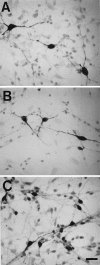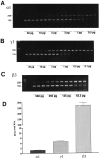GABAA receptors mediate trophic effects of GABA on embryonic brainstem monoamine neurons in vitro
- PMID: 9065503
- PMCID: PMC6573491
- DOI: 10.1523/JNEUROSCI.17-07-02420.1997
GABAA receptors mediate trophic effects of GABA on embryonic brainstem monoamine neurons in vitro
Abstract
The inhibitory neurotransmitter GABA may act as a trophic signal for developing monoamine neurons in embryonic rat brain, because GABA neurons and their receptors appear in brainstem during generation of monoamine neurons. To test this hypothesis, we used dissociated cell cultures from embryonic day 14 rat brainstem, which contains developing serotonin (5-HT), noradrenaline (tyrosine hydroxylase; TH), and GABA neurons. Immunocytochemistry and reverse transcription-PCR (RT-PCR) revealed the presence of multiple alpha, beta, gamma, and delta subunits in these cultures. Competitive RT-PCR demonstrated high levels of beta3 subunit transcripts. Expression of functional GABAA receptors was demonstrated using 36Cl- flux assays. To investigate GABAergic regulation of neuronal survival and growth, cultures were treated for 1-3 d in vitro with 10 microM GABA and/or GABAA antagonist (bicuculline or the pesticide dieldrin). The effects of treatments were quantified by analysis of immunoreactive 5-HT, TH, and GABA neurons. GABAA receptor ligands differentially regulated neuronal survival and growth depending on neurotransmitter phenotype. GABA exerted positive effects on monoamine neurons, which were countered by bicuculline (and dieldrin, 5-HT neurons only). By itself, bicuculline produced inhibitory effects on both 5-HT and TH neurons, whereas dieldrin potently inhibited 5-HT neurons only. GABA neurons responded positively to both antagonists, but more strongly to bicuculline. Taken together, these results demonstrate that the activation/inhibition of GABAA receptors produces opposite effects on the development of embryonic monoamine and GABA neurons. This suggests that these neurotransmitter phenotypes may express GABAA receptors that differ in fundamental ways, and these differences determine the developmental responses of these cells to GABAergic stimuli.
Figures







Similar articles
-
Prenatal exposure to the pesticide dieldrin or the GABA(A) receptor antagonist bicuculline differentially alters expression of GABA(A) receptor subunit mRNAs in fetal rat brainstem.Dev Neurosci. 1998;20(1):83-92. doi: 10.1159/000017302. Dev Neurosci. 1998. PMID: 9600394
-
GABA as a trophic factor for developing monoamine neurons.Perspect Dev Neurobiol. 1998;5(2-3):247-59. Perspect Dev Neurobiol. 1998. PMID: 9777640 Review.
-
Regulation of GABA(A) receptor subunit mRNA expression by the pesticide dieldrin in embryonic brainstem cultures: a quantitative, competitive reverse transcription-polymerase chain reaction study.J Neurosci Res. 1997 Sep 1;49(5):645-53. doi: 10.1002/(SICI)1097-4547(19970901)49:5<645::AID-JNR15>3.0.CO;2-U. J Neurosci Res. 1997. PMID: 9302086
-
Prenatal exposure to neurotoxicants dieldrin or lindane alters tert-butylbicyclophosphorothionate binding to GABA(A) receptors in fetal rat brainstem.Dev Neurosci. 1998;20(1):34-41. doi: 10.1159/000017296. Dev Neurosci. 1998. PMID: 9600388
-
GABAA and GABAB receptors and the ionic mechanisms mediating their effects on locus coeruleus neurons.Prog Brain Res. 1991;88:187-95. doi: 10.1016/s0079-6123(08)63808-x. Prog Brain Res. 1991. PMID: 1667544 Review.
Cited by
-
Morphofunctional plasticity in the adult hypothalamus induces regulation of polysialic acid-neural cell adhesion molecule through changing activity and expression levels of polysialyltransferases.J Neurosci. 2000 Apr 1;20(7):2551-7. doi: 10.1523/JNEUROSCI.20-07-02551.2000. J Neurosci. 2000. PMID: 10729335 Free PMC article.
-
Prenatal exposure to valproic acid disturbs the enkephalinergic system functioning, basal hedonic tone, and emotional responses in an animal model of autism.Psychopharmacology (Berl). 2007 Sep;193(4):547-55. doi: 10.1007/s00213-007-0795-y. Epub 2007 May 13. Psychopharmacology (Berl). 2007. PMID: 17497229
-
Dynamic expression of a glutamate decarboxylase gene in multiple non-neural tissues during mouse development.BMC Dev Biol. 2001;1:1. doi: 10.1186/1471-213x-1-1. Epub 2001 Jan 8. BMC Dev Biol. 2001. PMID: 11178105 Free PMC article.
-
Cleft palate in mice with a targeted mutation in the gamma-aminobutyric acid-producing enzyme glutamic acid decarboxylase 67.Proc Natl Acad Sci U S A. 1997 Oct 14;94(21):11451-5. doi: 10.1073/pnas.94.21.11451. Proc Natl Acad Sci U S A. 1997. PMID: 9326630 Free PMC article.
-
Developmental exposure to the organochlorine insecticide endosulfan alters expression of proteins associated with neurotransmission in the frontal cortex.Synapse. 2014 Nov;68(11):485-97. doi: 10.1002/syn.21764. Epub 2014 Jul 25. Synapse. 2014. PMID: 25042905 Free PMC article.
References
-
- Abalis IM, Eldefrawi ME, Eldefrawi AT. Effects of insecticides on GABA-induced chloride influx into rat brain microsacs. J Toxicol Environ Health. 1986;18:13–23. - PubMed
-
- Abraham JH, Seiler N, Schousboe A. Induction of low-affinity GABAA receptor by the GABA-agonist THIP in cultured rat cerebellar granule cells is prevented by inhibition of polyamine biosynthesis. J Neurosci Res. 1994;39:656–662. - PubMed
-
- Barbin G, Pollard H, Gaiarsa JL, Ben-Ari Y. Involvement of GABAA receptors in the outgrowth of cultured hippocampal neurons. Neurosci Lett. 1993;152:150–154. - PubMed
-
- Barnard EA. The structure of the GABA/benzodiazepine receptor complex with its gated ion channel. In: Squires RP, editor. GABA and benzodiazepine receptors. CRC; Boca Raton, FL: 1988. pp. 103–122.
-
- Becquet D, Hery M, Francois-Bellan AM, Giraud P, Deprez P, Faudon M, Fache MP, Hery F. Glutamate, GABA, glycine and taurine modulate serotonin synthesis and release in rostral and caudal rhombencephalic raphe cells in primary cultures. Neurochem Int. 1993;23:269–283. - PubMed
Publication types
MeSH terms
Substances
Grants and funding
LinkOut - more resources
Full Text Sources
